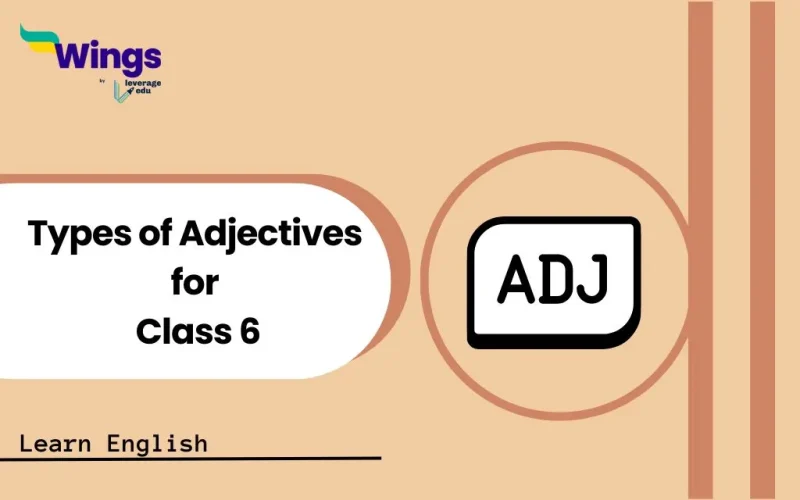Adjectives are an important part of speech in the English language as they help in making the sentence. They are known as describing words or modifying words. Pronouns can also have their meaning changed by the usage of adjectives. There are several types of adjectives for class 6 students which one must know. Keep reading this blog post to know all about the types of adjectives for class 6 and how they can be used in the construction of sentences.
This Blog Includes:
Types of Adjectives for Class 6
Adjectives are a crucial part of English grammar and for any student who wants to begin their English language learning journey. Check out the list of adjectives for Class 6 and what is their use in the formation of a sentence.
Adjectives of Quality
Adjectives of quality are used to describe the characteristics or qualities of a noun. They tell us something about the noun’s nature, appearance, or condition.
Here are some examples of adjectives of quality and how they are used in sentences:
- A delicious apple (delicious describes the apple’s taste)
- A beautiful flower (beautiful describes the flower’s appearance)
- A kind person (kind describes the person’s character)
Proper Adjectives
Proper adjectives are used to describe a specific noun. These adjectives are always capitalised when used in the sentence. Proper nouns refer to the name of a particular person, place, or thing.
Examples of proper adjectives include:
- American flag (derived from the proper noun “America”)
- Italian food (derived from the proper noun “Italy”)
- Shakespearean plays (derived from the proper noun “Shakespeare”)
- Victorian architecture (derived from the proper noun “Victoria”)
Adjective of Number
Numerical adjectives are used to describe how many or how much of something there is. These adjectives help us to describe nouns by giving us more information about quantity or order.
Here are some examples of adjectives of number:
- Cardinal numbers: one, two, three, four, five, etc.
- Example: There are three apples on the table.
- Ordinal numbers: first, second, third, fourth, fifth, etc.
- Example: This is the third time I’ve asked you.
- Quantifiers: many, few, a lot of, some, any, much, little
- Example: We have many books in our library.
Demonstrative Adjective
Demonstrative adjectives are used to highlight specific nouns or pronouns. They help to indicate whether something is near or far, or if it’s something we’ve already talked about or something new.
Some of the common examples of demonstrative adjectives include:
- This book is interesting. (This refers to a book close to the speaker)
- Those flowers are beautiful. (Those refer to flowers farther away from the speaker)
Distributive Adjective
Distributive adjectives are used to refer to individual members of a group. They indicate that something is given or distributed to each group member separately.
Take a look at some examples of distributive adjectives and how they can be used in sentences:
- Each: Each student received a textbook.
- Every: Every person in the room had a ticket.
- Either: Either option is acceptable.
Interrogative Adjective
Interrogative adjectives are used to ask questions about nouns. They are placed before the noun they modify. The interrogation takes place in words like “what, which, and whose”.
Examples:
- What colour is your car?
- Which book do you prefer?
- Whose dog is that?
Adjective of Quantity
Adjectives of quantity describe the amount or number of something. They tell us how much or how many there are. They provide a more detailed description of nouns, going beyond basic attributes like size or colour.
Here are some examples of adjective of quantity for you:
- Many: There are many people in the park.
- Few: She has few friends.
- Some: I ate some apples.
Possessive Adjective
Possessive adjectives show ownership or possession. They are used to indicate that something belongs to someone or something else.
Here are some examples of possessive adjectives:
My: This is my book.
Your: Is that your phone?
His: He lost his keys.
Also Read: Exercises on Adjectives for Class 4
Types of Adjectives for Class 6 Worksheet
Now that you have gained all the knowledge about the types of adjectives for class 6, it is time to test your knowledge. We have compiled a worksheet which you can easily download and use it for future reference.
Check out more blogs on Adjectives here!
FAQs on Types of Adjectives for Class 6
Any student beginning with his language learning journey will come across adjectives. Some of the common types of adjectives for Class 6 students are: Adjectives of quality, number and quantity. Then there are interrogative, possessive and demonstrative adjectives.
Nouns and pronouns are described or modified by adjectives, which also limit or restrict their meaning. Huge, crimson, angry, tremendous, unusual, rare, and so on are some examples of the attributes they might name. Typically, a noun is followed immediately by an adjective: “a red dress,” or “fifteen people.”
Adjectives are simply words that are used to describe nouns or pronouns. Being descriptive helps the reader or listener get a better idea about what you are trying to describe.
This was all about Types of Adjectives for Class 6. You can also follow the Learn English page of Leverage Edu for more exciting and informative blogs related to English grammar and the English language.
 One app for all your study abroad needs
One app for all your study abroad needs















 60,000+ students trusted us with their dreams. Take the first step today!
60,000+ students trusted us with their dreams. Take the first step today!

